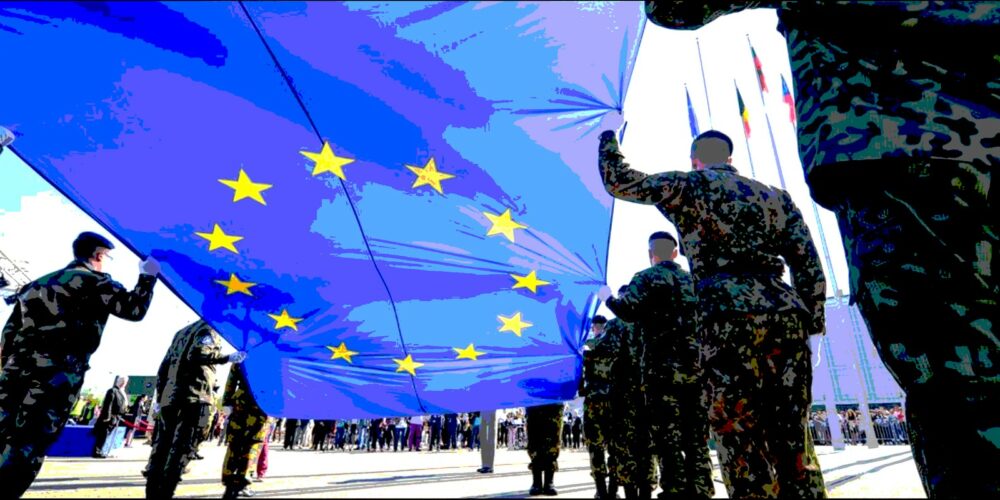According to its high representative for foreign affairs, Josep Borrell, the EU at present has 5,000 troops stationed around the world under its aegis.¹ Most of its operations are based in Africa (as shown in part 1 of this article). However, the EU’s most significant operation on the European continent is the advisory mission to Ukraine (EUAM).
EU member-states have been important backers of the regime in Kiev that took power in the 2014 coup. Since then the EU has advanced billions in loans to the country. The EUAM defines its role as helping the regime to create new state institutions in line with EU norms.² (It should be noted that there are Irish officials working in the EUAM’s Lviv office.³)
In December 2020 Ukraine’s National Police launched two new data centres at undisclosed sites to bolster its surveillance capacities.⁴ The data centres were procured with EU funds. The medium-term goal is to have Ukraine join the bloc, where its weak economy will suffer the same deflation and economic ruin that have befallen the other eastern European member-states, dominated by the imperialist core and representing a vast reserve army of labour for German industrial capital.
Not surprisingly, China is increasingly a central focus of EU foreign policy. The EU diplomatic corps’ directorate for the Asia-Pacific region identifies China as “an economic competitor and a systemic rival.”⁵ At the 21st EU-China summit in April 2019 the delegations agreed a framework for rules-based trade and a common position on reform of the WTO. The EU has been complaining for years that China provides subsidies for industry, and that EU companies do not have reciprocal access to Chinese markets. The hypocrisy inherent in EU accusations of unfair practices hides the fact that European companies are far less competitive than Chinese ones, despite the EU and its member-state governments regularly subsidising their own corporate giants (thereby giving handouts to their private shareholders); one need only refer to disputes between Airbus and the American aviation giant Boeing.
The nature of such EU-China negotiations nonetheless reveals that European big business, faced with declining rates of profit, is extremely keen to boost its commercial viability by breaking into Chinese markets. This contrasts with the extremely belligerent tone towards China from the new Biden government. After a meeting between senior EU and US diplomats on 25 March last, Borrell stated that there would be a co-ordinated approach towards China, while the US secretary of state, Anthony Blinken, insisted that NATO allies should mount a “pushback on Beijing,” under American leadership.⁶
Blinken clarified that the United States would not force its allies into an “us or them” choice over China, suggesting that it is being careful not to alienate the EU, which is capable of pursuing an independent policy on China if it considers American policy to be counterproductive.
As seen in part 1, the EU is using the new powers conferred on it by the Lisbon Treaty to develop a European military-industrial complex. Initiatives such as the European Defence Fund (EDF) stipulate that for a project to receive a grant it must involve at least three entities from at least three member-states. A report requested by the EU Parliament subcommittee on defence identified criticism of the EDF and similar initiatives by referring to the line of argument that “the major prime contractors in Western Europe will win all the high-tech work, leaving the other defence industries at risk.”⁷
The drive to create a single market for armaments procurement is presented as being a boon for small and medium businesses; however, the EU Commission’s own web site states that most of the companies forming commercial partnerships are concentrated in five member-states: France, Germany, Italy, Spain, and Sweden.⁸ Member-state governments are making funds available through such instruments as the EDF and the €2½ billion COSME programme, the latter exclusively aimed at small businesses, to bankroll the renovation and expansion of the bloc’s largest armed forces.⁹
For instance, the EU’s comprehensive annual defence review in 2020, the first of its kind, listed the upgrading of the main battle tank (MBT) capability for high-intensity operations as a priority.¹⁰ MBT is a collaboration between French and German manufacturers to equip their armies with a future land warfare system, potentially including autonomous ground and aerial vehicles.
Furthermore, the EU has a certification scheme (Certider) for companies wishing to receive certain military-related products and obtain transfer licences for items on the common EU military list.¹¹ Out of the 87 certifications listed in Certider’s database, 52 are held by companies registered in only three member-states: France, Germany, and Belgium.¹²
Given that the EU is seeking to create an internal market for military procurement, it is not surprising that third countries face substantial regulatory barriers in access to EU funds for R&D projects. According to the report requested by the EU Parliament subcommittee, “the US has been lobbying heavily over participation criteria in EU defence projects, although these efforts have been largely unsuccessful.”¹³ The American Chamber of Commerce to the EU even warned that a “Buy European Act” would lead to the United States restricting European companies’ access to American arms markets.
This is yet further evidence of the growing divide between the ruling classes on either side of the Atlantic, as the EU’s policy of “strategic autonomy” (discussed in part 1) necessitates an unwinding of EU-US military integration.
Companies certified by the Certider scheme include Thales Group (France), Safran (France), Leonardo (Italy), Rheinmetall (Germany), Diehl (Germany), and joint ventures such as MBDA Missile Systems.¹⁴ Each of these companies has a turnover of several billion euros. It is clear which countries are laying down the terms for armaments initiatives at the EU level, from which these same countries’ “captains of industry” will benefit most.
The increased powers for EU institutions in matters of defence means that Irish defence policy is being shaped by decisions taken on the Continent. Seventeen PESCO projects were officially initiated by EU defence ministers in March 2018, of which the Irish state is involved in two: the EU Training Mission Competence Centre and the Upgrade of Maritime Surveillance (UMS).¹⁵ As part of the former, the Defence Forces will send trainers abroad for “upskilling” so that they will have the expertise to prepare for future EU training missions. The latter is a surveillance project that will integrate land, air and sea systems to provide real-time information to member-states. Its emphasis is on “new and old threats”; in addition to security and defence matters, energy security is a central component of the UMS’s remit.¹⁶
Of the nine member-states participating in the UMS, seven border the Mediterranean, so it is clear that the Irish navy will be subservient to the geopolitical interests of France, Italy, Spain, and Greece, all of which are participants in the UMS.
These two PESCO projects are “legally binding” commitments on the Irish government, which must present a national implementation plan to the other member-states each year, outlining the progress made on the binding commitments it has undertaken.¹⁷
The Department of Defence is increasingly consumed by commitments to the EU’s military agenda. On 22 March last the EU launched its “European Peace Facility” (EPF), yet another “instrument” for advancing military initiatives under the common foreign and security policy. The fund will be worth €5 billion for the period 2021–27.¹⁸ It was reported last November that the EPF would have “significant cost implications for the exchequer.” With Britain no longer helping to foot the bill, the Irish state’s contribution will rise sharply from the outlay of €53.1 million for participation in overseas “peace support” missions in 2018.¹⁹
The white paper published by the Department of Defence in February further illustrates how the department will increase the state’s military capabilities by making use of EU subsidies for military research. The department has established a “Security and Defence Enterprise Group” to support Irish businesses in their efforts to gain access to programmes of the European Defence Agency (which helps to administer the EDF) and Horizon 2020.²⁰
The white paper also states that opportunities for joint research between the Defence Forces, businesses and third-level colleges will be pursued. Projects still to be completed include expanding the state’s participation in multinational development projects “within the framework of the EDA” and the initiation of “joint civil-military training” to support the “EU comprehensive/integrated approach” to crisis management.
Such measures show a desire to increase the visibility and influence of the Defence Forces in public life by advocating increased interaction between the military and the rest of society, particularly in commercial research ventures.
In conclusion: The Irish electorate decided in 2009 to vote in favour of a treaty based on lies proffered by the government and media with regard to the consequences for the state’s neutrality. As shown in this article, the Irish state is no longer just a conduit for US warplanes landing at Shannon Airport but actively implements legally binding military obligations to the EU, whether in the form of PESCO, submitting tenders to the EDF, or advisory missions such as the EUAM in Ukraine.
No part of the EU’s military bureaucracy is accountable to voters in this state, while the largest member-states use it to advance their own imperialist interests and develop an EU-wide military-industrial complex directed by the largest armaments contractors.
The anti-war movement in Ireland needs to campaign against the state’s involvement in the entire gamut of EU military projects, which are even more pervasive than the use of Shannon by US warplanes. Working-class and republican movements relate strongly to the anti-imperialist nature of struggles that define modern Irish history, and the demand to dissociate from the fledgling EU army is one that can win broad support.
References
- “Moving forward on European defence,” HR/VP blog, 28 February 2021 (https://eeas.europa.eu/headquarters/headquarters-homepage/93928/moving-forward-european-defence_en).
- European Union Advisory Mission (Ukraine), “About us” (https://www.euam-ukraine.eu/our-mission/about-us/).
- European Union Advisory Mission (Ukraine), “Field Office Lviv” (https://www.euam-ukraine.eu/tag/lviv/).
- European Union Advisory Mission (Ukraine), “EU supports creation of state-of-the-art data centres to enhance National Police operations,” 4 December 2020 (https://www.euam-ukraine.eu/news/eu-supports-creation-of-state-of-the-art-data-centres-to-enhance-national-police-operations/).
- European External Action Service, Annual Activity Report, 2019, p. 20 (https://eeas.europa.eu/sites/default/files/eeas_annual_activity_report_2 019_-_final_for_web.pdf ).
- Big News Network, “EU, US agree to coordinate actions towards China,” 25 March 2021 (https://www.bignewsnetwork.com/news/268194948/eu-us-agree-to-coordinate-actions-towards-china).
- Report for EU Parliament Sub-Committee on Security and Defence, “The EU’s Defence Technological and Industrial Base,” January 2020, p. 15 (https://www.europarl.europa.eu/RegData/etudes/IDAN/2020/603483/EXPO_IDA(2020)603483_EN.pdf).
- European Commission, “Defence Industries” (https://ec.europa.eu/growth/sectors/defence_en).
- European Commission, “Defence-related SMEs” (https://ec.europa.eu/growth/sectors/defence/smes_en).
- European Defence Agency, Comprehensive Annual Review on Defence, 2020 (https://eda.europa.eu/docs/default-source/reports/card-2020-executive-summary-report.pdf).
- ASD Europe, Internal Defence Market (https://www.asd-europe.org/defence-market).
- European Commission, Certified Enterprises Register (https://ec.europa.eu/growth/tools-databases/certider/index.cfm?fuseaction=undertakings.countries).
- Report for European Parliament Sub-Committee on Security and Defence, “The EU’s Defence Technological and Industrial Base,” January 2020, p. 14 (https://www.europarl.europa.eu/RegData/etudes/IDAN/2020/603483/EXPO_IDA(2020)603483_EN.pdf).
- European Commission, Certified Enterprises Register (https://ec.europa.eu/growth/tools-databases/certider/index.cfm?fuseaction=undertakings.countries).
- Institute of International and European Affairs, “Ireland’s Involvement in PESCO” (https://www.iiea.com/iiea-blog/irelands-involvement-in-pesco/).
- PESCO, “Upgrade of Maritime Surveillance” (https://pesco.europa.eu/project/upgrade-of-maritime-surveillance/).
- PESCO factsheet, November 2020 (https://eeas.europa.eu/sites/default/files/pesco_factsheet_november_2020-v1.pdf).
- European Council, “EU sets up the European Peace Facility,” 22 March 2021 (https://www.consilium.europa.eu/en/press/press-releases/2021/03/22/eu-sets-up-the-european-peace-facility/).
- Martin Wall, “EU defence plan to present Ireland with ‘significant’ costs,” Irish Times, 9 November 2020 (https://www.irishtimes.com/news/ireland/irish-news/eu-defence-plan-to-present-ireland-with-significant-costs-1.4403727).
- Department of Defence, White Paper on Defence Implementation Programme, February 2021, p. 5 (https://www.gov.ie/en/publication/b1410-white-paper-on-defence-implementation-programme-february-2021/).






